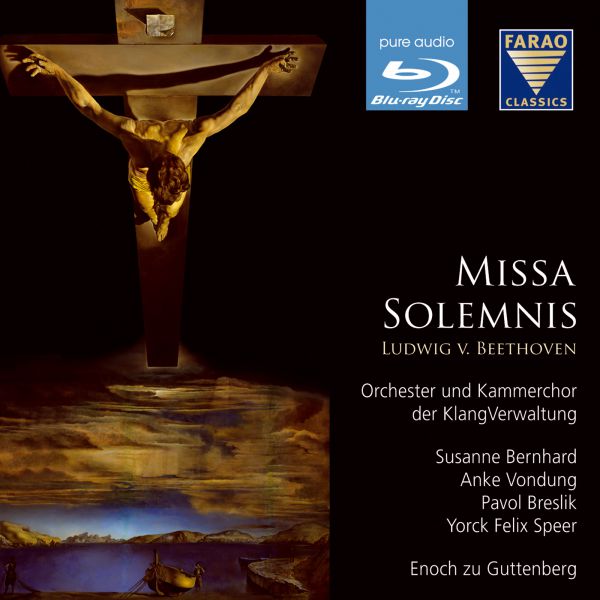

Order number: A 108 054

Price € 19,50
Shipment costs € 3,90 (worldwide)
free above € 30,00 order
Shipment costs € 3,90 (worldwide)
free above € 30,00 order
Download available:
HIGHRESAUDIOOrder number: A 108 054

Beethoven | Missa Solemnis (pure audio Blu-ray)
KlangVerwaltung - Enoch zu Guttenberg
Live recording from the Hercules Concert Hall of the Munich Residence, 2009
Blu-ray Pure Audio Disc (no video content included!), additional CD
Beethoven´s Missa Solemnis
Ludwig van Beethoven himself called the Missa Solemnis his most complete work – and yes, the composition still ranks among the most popular works in the occidental art genre.Archbishop Rudolph from Austria, Beethoven’s talented student, close friend and financial supporter, provided an opportunity for the creation of the Missa Solemnis when he was appointed Archbishop of Olmuetz. Spontaneously, Beethoven decided to compose this ceremonial mass for the enthronement.
Beethoven was neither religious nor an unbeliever. He concerned himself with writings from ancient Egypt, the philosophy of Kant and claimed to recognise the existence of God in the beauty of nature. He was not known for his ecclesiastical lifestyle which is why the examination of his own notion of God and the related studies of theology, liturgy and church music, which Beethoven considered to be necessary for his composition of the Missa Solemnis, took him much more time than expected. He worked on this piece for nearly four years. Unfortunately, his plan for the mass to accompany the bishop’s enthronement sadly failed. In 1823, three years after the enthronement, Ludwig van Beethoven handed over the Missa Solemnis to the Archbishop of Olmuetz to whom the work was dedicated.
Its first performance did not take place in a sacral environment, but at the Philharmonic Society of St. Petersburg, where it was played in April 1824 on the initiative of Prince Galitzin.
Missa Solemnis is not pure church music, a number of symphonic sections constitute a large part of the mass. It demands enormous technical and vocal expertise from the soloists, choir and orchestra. To give just one example, the credo’s finale is considered among experts to be one of the most challenging tone sequences in choral music.
"Art has to carry content", says the conductor, "the listener has to understand the story that is told." Zu Guttenberg knows how to interpret Beethoven’s varied musical allegories and images vividly and rich in contrast. Based on the denotation of the liturgy and the images an extraordinarily strong dynamic in music and density emerges. Human humility and the glory of God mingle and build a striking contrast in sound. Knowing the theological references in the score very well, zu Guttenberg manages to put the interpretation and the presentation of this work into the service of an approach, which allows the listener to perceive it in a completely new way.
Ludwig van Beethoven signed his work with the motto "From the heart – it shall again touch hearts". Enoch zu Guttenberg has taken this motto and made it the benchmark for his interpretation.
Press review
Audiophile Audition
... what we do hear is a very impressively sung performance with excellent soloists that actually provides us with an idea as to how this work might have come across to its first audiences … this is a performance that anyone with an interest in the work should hear … This is a Blu-ray disc with a companion CD, and the sound of the lossless DTS surround is dazzling …Steven Ritter, August 26, 2010
www.classical.net
... Guttenberg certainly knows his Beethoven and his soloists rise to the occasion with Bernhard particularly enticing with her silky smooth dulcet tones.The pacing of the work is also quite good with the acoustics extremely tangible and the well trained chorus obviously sings the music to the manner born ... this is a viable alternative in the pantheon of giants.Gerald Fenech, August 2010
www.allmusic.com
… one of Germany's most exciting small choirs ... a committed performance that merits attention, and many will find this to be an exciting rendition of Beethoven's greatest mass.Blair Sanderson, August 2010

